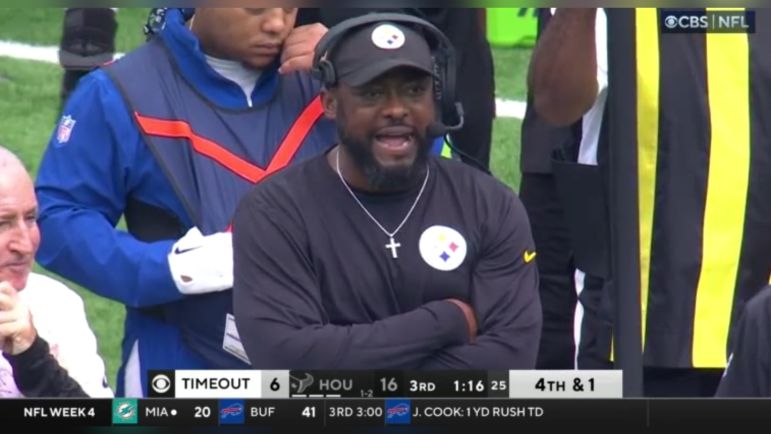Seriously?!
That was my literal and audible reaction when Mike Tomlin tried to explain away the Pittsburgh Steelers’ 4th-and-one failure in Sunday’s loss to the Houston Texans. A play we’ve talked about a half-dozen times already. But the more you hear about it, the worse you get.
During his Tuesday press conference, Tomlin was asked about the team’s decision to throw the ball on fourth down. And not just throw it but to align in shotgun with a five-step drop on a play where Pittsburgh needed three feet. It failed, QB Kenny Pickett was injured, and the Texans took over on downs and promptly salted the game away with a touchdown. Attempting to rationalize the decision, Tomlin said:
“To be completely transparent with you, we lost a lot of short-yardage personality because of Dan Moore and Pat Freiermuth. We lost all our big packages. Broderick Jones was already on the field. And so we probably had to get out of our intended box, if you will, in that circumstance because of lack of player availability at that point in the game.”
Moore left in the first quarter with a knee injury, Freiermuth earlier in the third quarter with a hamstring. It’s true both were unavailable for that fourth-down play call. Tomlin’s assertion is Pittsburgh lacked the personnel to go heavy and run the ball effectively. While it’s true Pittsburgh couldn’t have confidently gone in say, 12 personnel, that’s far from the team’s only option if the coaches want to run the ball.
All Pittsburgh had to do was this. Run the ball out of 11 personnel. Ta dah!
After (another) slow first half, Pittsburgh’s offense finally found traction in the third quarter. They moved the ball primarily through the running game. And exclusively out of 11 personnel. I went back through the third quarter leading up to that fourth-down play to chart each of the Steelers’ runs. What personnel grouping they used, how many yards they gained, and who the tight end(s) were on that play. Here are the results.
| Yardage Gained | Personnel Grouping | Tight Ends Used |
|---|---|---|
| 15 Yards | 11 | Washington |
| 4 Yards | 11 | Heyward |
| -1 Yards | 11 | Heyward |
| 18 Yards | 11 | Washington |
| 4 Yards | 11 | Washington |
| 4 Yards | 11 | Washington |
| -2 Yards | 11 | Freiermuth |
| 2 Yards | 11 | Washington |
| 3 Yards | 11 | Heyward |
| 23 Yards | 11 | Heyward |
| -1 Yards | 11 | Washington |
| -8 Yards | 11 | Washington |
Twelve runs. All out of 11 personnel, the team’s three-receiver set. Only *one* of them had Freiermuth on the field, a two-yard loss where he was run into the backfield, blowing up the play.
Yeah, sure, Pittsburgh was really missing that guy on 4th and short.
The other 11 runs without Freiermuth totaled 63 yards, an average of 5.7 yards per rush. The biggest negative outcome was the loss of eight on the final run play before the fourth-down call, which wasn’t Washington’s fault (in fairness, Harris’ 15-yard run to start the quarter came despite Washington, who failed to secure his block on the play).
But the overall point here is Pittsburgh was having plenty of success running out of 11 personnel in that quarter with just one tight end on the field. Use that grouping, keep Najee Harris on the field, and have him get downhill for a yard. Anything else is just excuses.
The Steelers have been a more successful team this season when they spread the ball out to run it as opposed to when they go heavy and condense the formation. That was true against the Raiders when they averaged 4.3 yards per carry out of 11 as opposed to 1.6 yards per carry out of 12/13 personnel, and it was true in that quarter against the Texans.
The only thing that stopped the Steelers from continuing to do what they were doing well was themselves. We know it, the players know it. After the game, center Mason Cole — usually quiet and reserved — said the Steelers get scared when they have a negative run, and it makes them abandon trying again. It’s why he was so angry after the incompletion. He knew they could run the ball, they should run the ball, and they didn’t.
Just be honest. Say it was a mistake. Poor judgment. You’d take it back if you could. For as much crap as he got, at least Carolina Panthers HC Frank Reich admitted as much when he called a play for WR Adam Thielen, who wasn’t in the game.
It’s been a frustrating start to the season, I know. Tensions run high and it’s easy to be a prisoner of the moment. But factually and intuitively, Tomlin’s explanation is one of the worst I’ve ever heard from him. It’s a messy paragraph of nonsensical excuses that don’t mesh with what was happening during the game. His answer wasn’t grounded in reality and was the sorriest response he could’ve offered.








